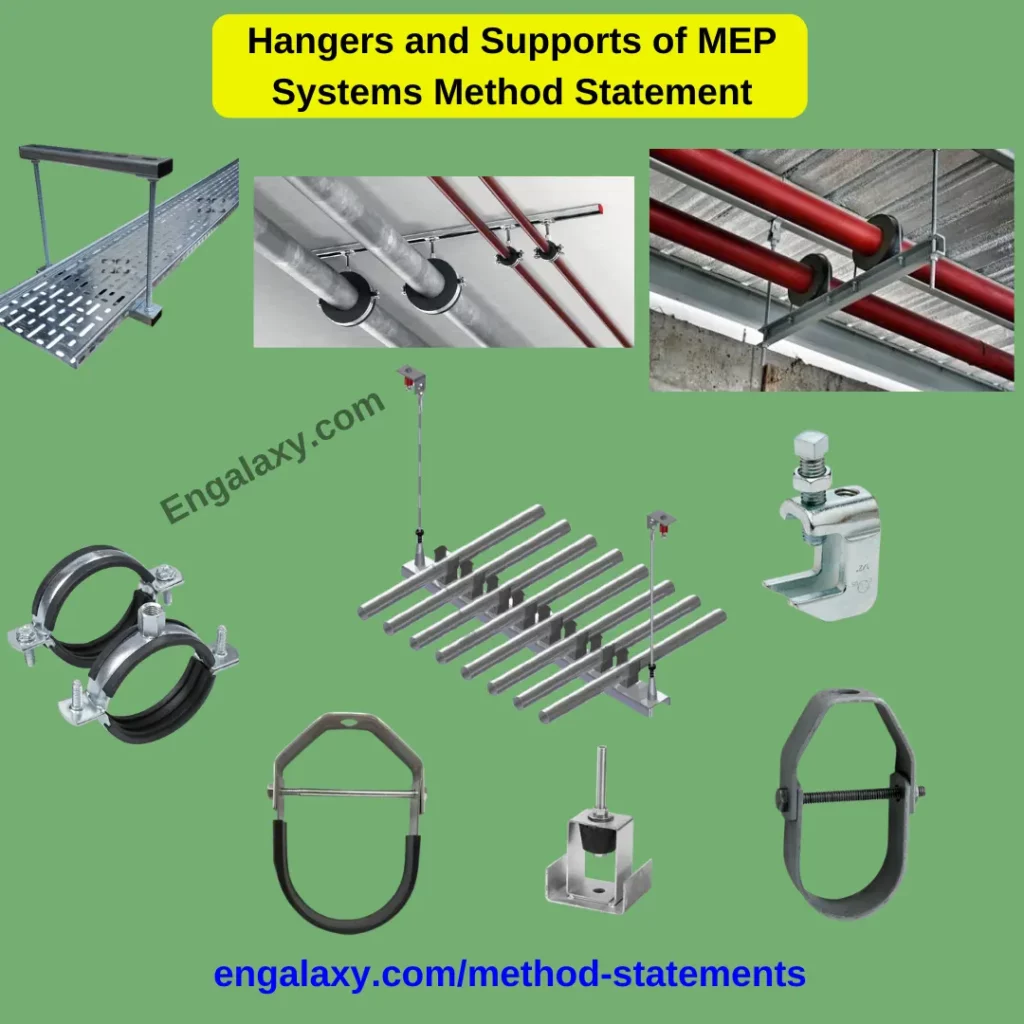MEP systems are essential components of any modern building, and the installation of hangers and supports is a key step in the process.
Proper installation is vital for the entire project’s success and must be done with the utmost attention to detail and professionalism.
So this method statement will discuss the processes that should be followed to ensure successful completion.
01- Contractor Details
The main contractor will undertake the works
02- Scope of Work
In this section, our scope of work is to install hangers, supports, clamps, and attachments as required.
This is to properly support MEP services for building structures, walls, slabs, or floors, such as Firefighting and Plumbing fixtures, Water Supply piping and equipment, Drainage piping, HVAC ducts, Split Air Conditioners, Electrical, and Control cabling.
This includes and is not limited to all other necessary equipment as per approved construction drawings and project specifications.
03- Programmed Duration of Activity
On-going for the duration of the building works as per contract.
04- Management Structure/Resources and Responsibilities
The overall works will be supervised by the main contractor’s MEP Manager Contact details will be in section 5 below
05- Communication/Contact Details:
Name Designation Mobile number
06- Method Statement
- All the materials will be used after the PI is done. All hangers and supports will be installed strictly following approved construction, Drawings and as per the size/weight of MEP piping, ducts, and equipment.
- All work shall strictly comply with project specifications, “HANGERS AND SUPPORTS PS10694-CD-SPC-ME-01, REV. 0, Section 15060”.
- Concrete inserts, powder-actuated fasteners, or structural-steel fasteners, Appropriate building materials, shall be used as building attachments.
- Hangers and supports will be installed within concrete slabs.
- When the concrete/slab is completely cured, the MEP supervisor will mark locations on the Concrete slab for all MEP services and equipment as per the approved construction Drawing.
Then holes of the required sizes will be drilled in the slab or wall as required.
- Anchor bolts of the required size will be pushed into the holes, and then threaded rods of the required sizes will be inserted into the anchor bolts and tightened.
- Powder-actuated concrete fasteners shall be used for standard-weight aggregate Concretes or for slabs more than 4 inches (100 mm) thick.
- Powder-actuated concrete fasteners shall not be used for lightweight-aggregate concrete or slabs less than 4 inches (100 mm).
- Hanger Materials shall be Galvanized, sheet steel, or round, threaded steel rods.
In Corrosive Atmospheres, only Electro galvanized, all-thread rods shall be installed, or galvanized rods with threads painted after installation.
- Straps and Rod Sizes shall comply with SMACNA’s “HVAC Duct Construction Standards-Metal and Flexible” for sheet steel width and thickness and for steel rod diameters.
- Fabricate structural steel stands to suspend equipment from the structure above or support equipment above the floor.
- Place grout under supports for equipment and make a smooth bearing surface.
- Additional hangers and supports shall be installed at concentrated loads, including Valves, flanges, strainers, and expansion joints, and at changes in the direction of piping if required.
- Hangers and supports shall be installed with complete necessary inserts, bolts, rods, nuts, washers, and other accessories.
- Hangers and supports shall be installed to allow controlled thermal and seismic movement of piping systems, to permit freedom of movement between pipe anchors, and to facilitate the action of expansion joints, expansion loops, expansion bends, and similar units.
- Hangers and supports shall be installed so that piping, ducting, and suspended equipment live and dead loads and stresses from movement- not be transmitted to connected equipment.
- Hangers and supports shall be installed so that piping, ducting, and suspended equipment live and dead loads stresses from movement not be transmitted to connected equipment.
- Hangers and supports shall be installed to provide indicated pipe slopes as in approved construction drawings.
- Support and space trapezes for the smallest pipe size or installs intermediate supports for smaller diameter pipes as specified above for individual pipe hangers.
- Adjust hangers to distribute loads equally on attachments and to achieve indicated slope of the pipe.
- Piping operating above Ambient Air Temperature, Clamp may project through insulation.
In Piping Operating below Ambient Air Temperature, use a thermal-hanger shield insert with a clamp sized to match the outlet diameter of the insert. Do not exceed pipe stress limits according to ASME B31.9.
- Clean abraded areas of shop paint. Paint exposed areas immediately after erecting hangers and supports. Use the same materials as used for shop painting.
Comply with SSPC-PA 1 requirements for touching up field-painted surfaces.
Apply paint by brush or spray to provide a minimum dry film thickness of 0.05mm.
- Clean and give a touch-up paint of field welds, bolted connections, and abraded areas of shop paint on miscellaneous metal.
- Clean welds, bolted connections, and abraded areas and applied galvanizing-repair paint to comply with ASTM A780.
- Inspection Request (IR) will be raised and forwarded to the consultant.
Control and Monitoring Site:
The site and project engineer shall monitor site installation and testing as per approved construction drawings.
Site engineers and project engineer will work under the directives of MEP Construction Manager.
QA/QC engineers and Inspectors shall monitor the work carried out by site engineers and project engineers as per approved construction drawings and approved ITP. At the same time, shall coordinate/report to QA/QC Manager and client for inspections and records.
HSE engineers, Inspectors, and Offices shall carry out regular daily, weekly, and monthly site HSE surveillance to maintain best HSE practices, identify all possible hazards and report to HSE Manager.
They shall inspect proper PPE and possible hazards daily to protect the system and comply with Project HSE policy.
07- ITP and Quality Records:
ITP and inspection checklist shall be followed during installation and available during inspection. The ITP will be as per the specs and Method statement.
08- Plant and Equipment
The crew will be provided with but not limited to, the following tools and equipment.
- Drilling machine and drill bits of all sizes.
- Measuring tapes.
- Mobile scaffoldings
- Brushes
- Technician box with all the tools
- Files
- Grinders
- Powder Actuated tools
09- Special Scaffold/Access Equipment
Normal Scaffolding will be required up to the slab level.
10- Training and Competency of Personnel
- Scaffolders will be fully qualified and certified.
- Technicians will be fully qualified.
11- First Aid and Emergency Arrangements
The site team will have a first aid kit available at the time of work. The site clinic is also operational as necessary.
12- Advise Any Permits to Work required
- Permit to work
- Hot work permit
13- Environmental Considerations
Not applicable
14- Waste Management
Housekeeping will be done daily. Solid waste segregations will be considered.
15- Hazardous Substances
Hazards:
- Fall from height
- Human body injury
Safety Equipment and PPE:
ALL workers shall be provided with safety shoes, safety helmets, safety glasses, safety harnesses, ear protection, safety belt, and gloves.
16- Special Storage Requirements
Chemical substances and paints will be stored in an air-conditioned store.
17- Testing and Commissioning:
No testing and commissioning are required for these hangers and supports.
18- Supporting Documents:
- Risk Assessment (RA)
- Inspection and Test Plan (ITP)
- Checklist
Please click on the next button if you want the complete editable file ( Word File )of this method statement and other method statements.
Also, If you would like to learn the different Mechanical practical installations on-site, you can have a look at our Mechanical Practical Installations Online course from this link:
Also, you can find all our published method statements on this link:
https://engalaxy.com/method-statements/
If You would like to learn more about the practical installations of the different MEP systems on-site, so have a look at our free MEP Mini-Course




